I want a nice, naturalistic home for a couple of small- to medium-sized turtles to enjoy.
The purpose of this demonstration turtle vivarium is to provide ideas for a simple, inexpensive, effective and attractive setup that is perfect for novice and young turtle enthusiasts, elementary school teachers or someone wanting an attractive, easily maintained turtle vivarium for their home or office.
Fish and Turtles
Turtles can indeed live with fish. However, there are some guidelines you must follow when combining the two. Most turtles are carnivorous and, of course, eat fish and other aquatic animals, such as crayfish, snails, tadpoles, etc.
Any fish you keep with turtles must be large and aggressive, so that they can hold their own and the turtles do not view them as prey. Many kinds of cichlids are noted for their aggressiveness and toughness. They can also be very beautiful. And many cichlid species like the kind of rocky environment I intended to create. So I decided to use them in this demonstration turtle vivarium. (Note: Some turtles, such as mud and musk turtles, aren’t strong swimmers, and these can sometimes be kept safely with fish too. —Eds.)
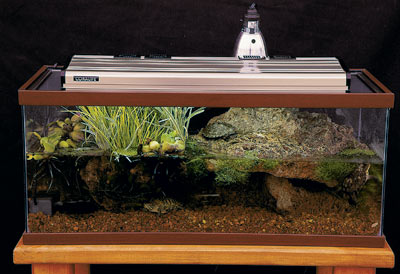 This simple, inexpensive natural turtle vivarium makes an attractive home for a group of young turtles. Photography by Mike Enyeart |
What You Need
I created this vivarium — from shopping for materials to the finished setup — in just a few hours. I used readily available items from local businesses all near you. And the entire project (not counting the turtles and fish) cost less than $200 to complete. Irregardless of where someone is from, they should be able to do the same.
The tank is a standard 20-gallon-long reptile tank with a sliding-screen top. This size of tank will provide enough space for two or three small to medium young turtles, as well as three or four medium-sized cichlids.
Although they are not intended for use with water like an aquarium tank, I often use reptile tanks for aquatic vivaria and have never had a problem with leakage. When only partially filled with water, they are perfectly strong. However, for any project that involves a full tank of water, an aquarium manufactured for this purpose should be used.
A Coralife 24-inch, double bulb (130 watt total), full-spectrum, daylight, compact fluorescent fixture is used to provide appropriate light that simulates both the spectrum and intensity of natural sunlight. This enables the plants to live and grow, as well as creating an environment that is good for both the physical and mental health of the animals. A Zoo Med 50-watt basking spotlight is positioned over the basking area, creating a bright, warm spot for the turtles to bask.
A Rio 180 water pump/filter is used to create a fairly strong current that moves over the gravel bottom, beginning in the front left corner and moving around the entire tank, pushing debris to the filter. This filtration, along with the plants that utilize animal waste as fertilizer, keeps the vivarium water clean and clear.
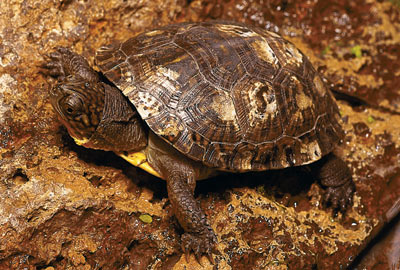 A Blanding’s turtle (Emydoidea blandingi) takes advantage of a vivarium basking rock. Basking sites are important for the health of aquatic turtles. Photography by Mike Enyeart |
An aquarium gravel vacuum is used occasionally to remove larger debris particles. As with any aquarium, occasional partial water changes are recommended. Although the precise water hardness is not that crucial for the turtles, the cichlids used for this vivarium need fairly hard water. I used reverse-osmosis purified water, specifically for freshwater aquaria, from a local tropical fish store. To the water I added about 11/2 tablespoons of R.O. Right per 10 gallons, along with a little liquid aquarium plant fertilizer.
The rock used with this terrarium is a volcanic type called “Mexican bowl lava” and was obtained from my favorite rock yard, Whitewater Rock (located near Palm Springs), where a large selection of it is always in stock. It may go by other names at various rock yards in various areas, but it, or a similar type, should be commonly available.
Mexican bowl lava is a very beautiful and useful rock that comes in all sorts of shapes, with holes, bowls, ledges, etc. It can be used to create caves and other hiding spots, rocky pools and craggy cliffs in terrestrial vivaria, or similar underwater features in aquaria. It has various tones of browns, reds and blacks and is very rugged. It looks appropriate for tropical forest, desert and aquatic vivaria. I also found a nice natural-looking brown aquarium gravel, which matches the Mexican bowl lava quite well.
Six Turtle-Safe Plants
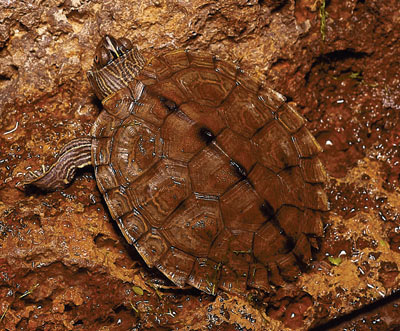 TMap turtles (Graptemys spp.) make hardy and interesting captives. They can coexist with other aquatic turtles and some fish. Photography by Mike Enyeart |
Using plants with turtles can be tricky. Turtles are like living tanks that can bulldoze and rip up many kinds of plants. Further, many turtles also supplement their diet of meat by snacking on various kinds of plant material. But you can create a nice, naturalistic, planted vivarium for turtles by using the right kind of plants in the right kind of spots.
For this vivarium I used six kinds of plants that usually work well with turtles. At a local nursery that carries pond plants, I purchased a pot of Japanese sweet flag (Acorus gramineus) and a pot of society garlic (Tulbaghia violacea). Both are quite happy growing as emergent bog plants, with their roots in the water and leaves in the air.
I planted these in a deep hole in one of the bowl lava rocks, using some of the gravel to fill in around the roots. They are very thick and very tough, and the turtles can’t do much damage to them. They are unpalatable, so the turtles won’t eat them, and the society garlic has nice blooms. The nursery also had some small water hyacinths (Eichhornia crassipes), a floating water plant.
In addition, I purchased some hornwort (Ceratophyllum demersum) and crystalwort (Riccia fluitans). These both do well simply floating free in the water. I had some duckweed (Lemna minor) in my greenhouse pond, so I threw some of that in as well. It is another small floating plant that in large numbers creates an attractive water surface.
All of these aquatic plants just sort of float around, so the turtles can push them around as much as they wish, without any problems. These plants also grow quickly, so the turtles can munch on them and not slow them down much.
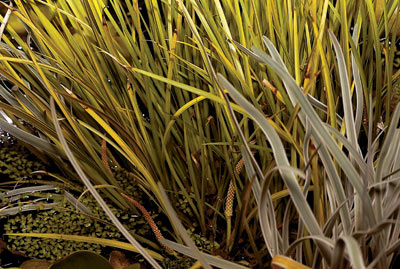 Japanese sweet flag and society garlic grow in this turtle pond, while duckweed floats on the water surface. Photography by Rex Lee Searcey |
Setup
Setting up the vivarium was simply a matter of laying the gravel bottom, selecting and placing the rock, sticking in the pump, arranging the plants and adding the water.
The rock positioning was the most time-consuming task. I arranged it so that there was plenty of swimming space, with various mini catacomb areas for the turtles and fish to use. One large, wide rock surface was positioned so its edge was just below the waterline. This created a convenient shoreline so the turtles could haul out onto the rock and bask. Another rock with a deep bowl was used to plant the sweet flag and society garlic.
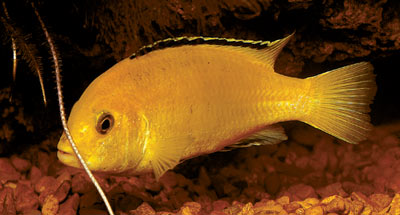 Several species of Lake Malawi cichlids are large and aggressive enough to share a vivarium with aquatic turtles. This is an electric yellow Labidochromis caeruleus. Photography by Rex Lee Searcey |
The fish were floated in their bags to acclimate them to the water temperature and then released. Finally, the turtles were introduced to their new home and on went the screen top and the lights.
After that, the reptile store staff and customers enjoyed watching the turtles and fish exploring their new home. The turtles settled right in and began enjoying the densely planted watery world and the spacious, warm basking area. The cichlids, as cichlids do, began chasing each other around and enjoying their rocky nooks and crannies.
This vivarium contains three turtles: a red-eared slider (Trachemys scripta elegans), a map turtle (Graptemys spp.) and a Blanding’s turtle (Emydoidea blandingi), all a year or less in age.
The fish are an assortment of pretty Lake Malawi cichlids from Africa. They include an electric yellow Labidochromis, a blue Pseudotropheus socolofi, an orange blotch zebra and a black female peacock.


